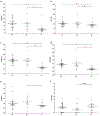Steroid hormone analysis of adolescents and young women with polycystic ovarian syndrome and adrenocortical dysfunction using UPC2-MS/MS
- PMID: 32247282
- PMCID: PMC7541460
- DOI: 10.1038/s41390-020-0870-1
Steroid hormone analysis of adolescents and young women with polycystic ovarian syndrome and adrenocortical dysfunction using UPC2-MS/MS
Abstract
Background: We recently identified 35 women with polycystic ovarian syndrome (PCOS) who exhibited features of micronodular adrenocortical hyperplasia. Steroid hormone analysis can be more accurate using state-of-the-art ultra-performance convergence chromatography-tandem mass spectrometry (UPC2-MS/MS). We hypothesized that UPC2-MS/MS may be used to better define hormonally this distinct subgroup of patients with PCOS.
Methods: Plasma from PCOS patients (n = 35) and healthy volunteers (HVs, n = 19) who all received dexamethasone testing was analyzed. Samples were grouped per dexamethasone responses and followed by UPC2-MS/MS analysis. When insufficient, samples were pooled from patients with similar responses to allow quantification over the low end of the assay.
Results: The C11-oxy C19 (11β-hydroxyandrostenedione, 11keto-androstenedione, 11β-hydroxytestosterone, 11keto-testosterone):C19 (androstenedione, testosterone) steroid ratio was decreased by 1.75-fold in PCOS patients compared to HVs. Downstream steroid metabolites 11β-hydroxyandrosterone and 11keto-androsterone were also measurable. The C11-oxy C21 steroids, 11-hydroxyprogesterone and 11keto-dihydroprogesterone levels, were 1.2- and 1.7-fold higher in PCOS patients compared to HVs, respectively.
Conclusions: We hypothesized that UPC2-MS/MS may accurately quantify steroids, in vivo, and identify novel metabolites in a subgroup of patients with PCOS and adrenal abnormalities. Indeed, it appears that adrenal C11-oxy steroids have the potential of being used diagnostically to identify younger women and adolescents with PCOS who also have some evidence of micronodular adrenocortical hyperplasia.
Impact: Adrenal C11-oxy steroids may be clinically important in identifying young patients with PCOS and adrenal abnormalities. The steroids presented in our manuscript have not yet been considered in the clinical setting so far, and we believe that this study could represent a first focused step towards the characterization of a distinct subgroup of women with PCOS who may in fact be treated differently than the average patient with PCOS. This paper can change the understanding of PCOS as one disorder: it is in fact a heterogeneous condition. In addition, for the subgroup of patients with PCOS associated with adrenocortical dysfunction, our paper provides novel hormonal markers that can be used diagnostically. Finally, the paper also adds to the basic pathophysiological understanding of adrenocortical-ovarian interactions in steroidogenesis of young women and adolescent girls with PCOS.
Figures




Similar articles
-
Analysis of 52 C19 and C21 steroids by UPC2-MS/MS: Characterising the C11-oxy steroid metabolome in serum.J Chromatogr B Analyt Technol Biomed Life Sci. 2020 Sep 1;1152:122243. doi: 10.1016/j.jchromb.2020.122243. Epub 2020 Jun 13. J Chromatogr B Analyt Technol Biomed Life Sci. 2020. PMID: 32593151
-
The 11β-hydroxyandrostenedione pathway and C11-oxy C21 backdoor pathway are active in benign prostatic hyperplasia yielding 11keto-testosterone and 11keto-progesterone.J Steroid Biochem Mol Biol. 2020 Feb;196:105497. doi: 10.1016/j.jsbmb.2019.105497. Epub 2019 Oct 15. J Steroid Biochem Mol Biol. 2020. PMID: 31626910
-
Profiling adrenal 11β-hydroxyandrostenedione metabolites in prostate cancer cells, tissue and plasma: UPC2-MS/MS quantification of 11β-hydroxytestosterone, 11keto-testosterone and 11keto-dihydrotestosterone.J Steroid Biochem Mol Biol. 2017 Feb;166:54-67. doi: 10.1016/j.jsbmb.2016.06.009. Epub 2016 Jun 21. J Steroid Biochem Mol Biol. 2017. PMID: 27345701
-
Back where it belongs: 11β-hydroxyandrostenedione compels the re-assessment of C11-oxy androgens in steroidogenesis.Mol Cell Endocrinol. 2021 Apr 5;525:111189. doi: 10.1016/j.mce.2021.111189. Epub 2021 Feb 2. Mol Cell Endocrinol. 2021. PMID: 33539964 Review.
-
Advances in the analytical methodologies: Profiling steroids in familiar pathways-challenging dogmas.J Steroid Biochem Mol Biol. 2015 Sep;153:80-92. doi: 10.1016/j.jsbmb.2015.04.009. Epub 2015 Apr 11. J Steroid Biochem Mol Biol. 2015. PMID: 25869556 Review.
Cited by
-
Comparative analysis of sexual function and psychological health in infertile patients with different ovarian dysfunctions.Sex Med. 2025 May 20;13(2):qfaf027. doi: 10.1093/sexmed/qfaf027. eCollection 2025 Apr. Sex Med. 2025. PMID: 40395230 Free PMC article.
-
Implicating androgen excess in propagating metabolic disease in polycystic ovary syndrome.Ther Adv Endocrinol Metab. 2020 Jun 24;11:2042018820934319. doi: 10.1177/2042018820934319. eCollection 2020. Ther Adv Endocrinol Metab. 2020. PMID: 32637065 Free PMC article. Review.
-
C11-hydroxy and C11-oxo C19 and C21 Steroids: Pre-Receptor Regulation and Interaction with Androgen and Progesterone Steroid Receptors.Int J Mol Sci. 2023 Dec 20;25(1):101. doi: 10.3390/ijms25010101. Int J Mol Sci. 2023. PMID: 38203272 Free PMC article.
References
-
- Azziz R, Black VY, Knochenhauer ES, Hines GA, Boots LR. Ovulation after glucocorticoid suppression of adrenal androgens in the polycystic ovary syndrome is not predicted by the basal dehydroepiandrosterone sulfate level. J Clin Endocrinol Metab. 1999;84(3):946–950. - PubMed
Publication types
MeSH terms
Substances
Grants and funding
LinkOut - more resources
Full Text Sources
Other Literature Sources
Medical

